Back in June we attempted an initial power ranking of the AFLW teams based on the strength of their state-based recruitment zones. As a quick reminder we came up with the following based on elite talent distribution and results in representative games:
1 – Fremantle
2 – Brisbane
3/4 – Melbourne/Bulldogs
5/6 – Collingwood/ Carlton
7/8 – GWS/Adelaide
We noted at the time that the key questions would be:
- How much of the glut of WA talent would Fremantle retain?
- Would Brisbane get all the top Queensland players?
- Would any Victorian teams end up more “stacked” than the others?
- Where will GWS and Adelaide source their players?
We’re going to publish more detailed club profiles and an updated power ranking based on these questions, but first, here’s a look at the overall statistical picture for each club. This will start to paint the picture.
States of Origin
Clubs have mostly recruited from their home states. This is unsurprising. With low pay (still unconfirmed but with negotiations apparently starting at a non-professional $5000 base), it was unlikely many players would relocate for the multi-month commitment, including preseason, without personal factors involved.
Secondly, as a consequence of non-professional pay levels, there were restrictive draft rules meaning that players nominated a single state they were willing to play in. That made the Victorian draft the only competitive component of the process.
The resulting lists look like this:
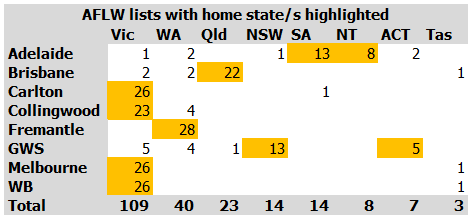
Fremantle is a depleted Western Australian state team and Brisbane are effectively the Queensland state team plus a handful of elite players from elsewhere.
Melbourne and the Bulldogs picked up a Tasmanian player each (Emma Humphries and Ellyse Gamble) while Carlton are purely Victorian except for a non-football rookie originally from SA (Kate Shierlaw). Collingwood are the only Victorian side to have looked significantly beyond their borders, recruiting four players from Western Australia.
GWS and Adelaide are unsurprisingly more mixed and relying significantly on their respective secondary markets of Canberra and the Northern Territory.
In an interesting side note for the Crows, and a small sign of how heavily location matters in the not-yet-professionalised AFLW, their list contains two Defence Force players originally from Canberra who just happen to currently be stationed in the Crows’ areas. There are in fact four serving Defence personnel recruited to the AFLW overall.
Here’s how the overall State of Origin of the 218 players selected looks, with Victorians making up half the numbers and Western Australia contributing nearly one-fifth of the talent:
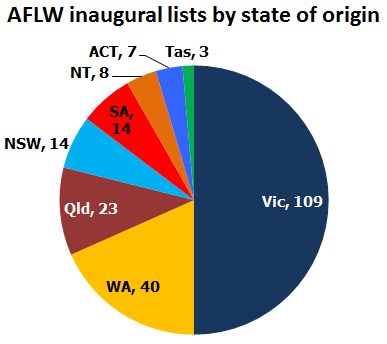
“State of origin” here means mostly the official listing of most recent Australian Rules club/league to determine what state each player is from. Players like Aasta O’Connor and Katie Brennan, who have long since relocated to play in the VFLW, are therefore labelled as Victorian though one assumes they’d front up for Queensland in a representative context.
However we’ve made some corrections where this was clearly nonsensical, such as in the case of Jenna McCormick who is from Mt Gambier, played W-League for Adelaide and Canberra United and was drafted “from Coorparoo” to the Crows after three games there. We’ve labelled her as from South Australia, not Queensland.
Clubs of origin
Next, here’s the most drafted clubs, illustrating the concentration of strength in Victoria at this year’s top five VFLW clubs and top three WAWFL clubs:
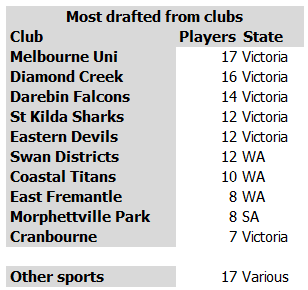
Six clubs, five from Victoria plus Swan Districts, have had the majority of a best-22 side drafted this year. Those players willl all still be able to play for their local teams due to the timing of the AFLW.
And here’s the leading club for each state:
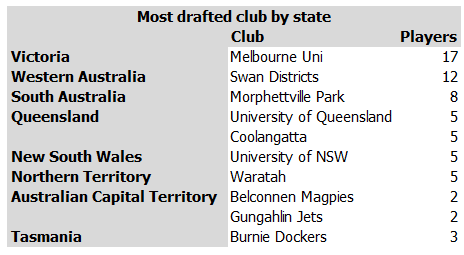
Morphettville Park and Waratah both contribute the majority of their competition’s players (making the Crows almost a temporary merger of the two sides). University sides lead the way for both Queensland and New South Wales, which otherwise have a more balanced distribution of AFL recruits. Two of the ACT’s seven players are GWS rookies Jess Bibby and Ellie Brush from basketball and soccer backgrounds respectively.
Elite talent distribution
Before can move into any form of power rankings we need to look at where the top end talent has ended up and how to define it.
For simplicity’s sake, we’re defining the cream of the competition at two levels. The less exclusive is “all-Star” level, the 75 players who played for the Bulldogs or Melbourne in the 2015 and 2016 All-Star representative games. The more exclusive is the “elite” third of this talent who were the first 25 players picked in 2015 (either by being prelisted by the two clubs or picked at the top of the min idraft).
This breaks the competition down roughly into the top 12% being “elite”, the rest of the top third being All-Star grade, with the remaining two thirds being depth:

We should note that a few edge cases must exist here – players who were injured or unavailable, young emerging players such as Sabrina Frederick-Traub who were only 18 in 2015 and have since improved, top level recruits from other sports who end up making an immediate impact.
However, as a proxy, selection in the All-Star games will represent a good view of the elite of the available talent.
The Elite and All-Star players have been recruited as follows:
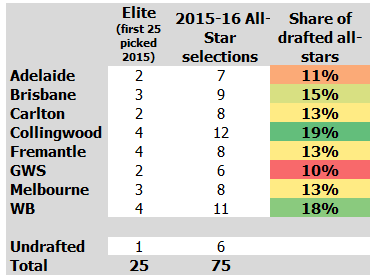
Or in graphical format (note that Fremantle and GWS have an extra player due to being permitted to replace long-term injured marquees Kiara Bowers and Renee Forth) the talent spread looks like this:
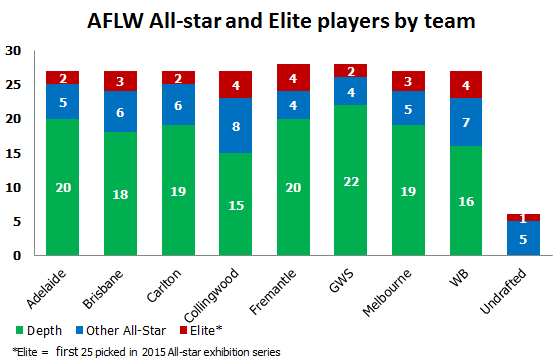
Collingwood and the Bulldogs have ended up with more proven top talent than Carlton and Melbourne, while Brisbane sits third in this view. Notably, this suggests the Pies and Dogs sides have the inside running to be best among the Victorian sides.
We can see the relative struggle that GWS and Adelaide, based in development markets without the benefit of any real locally-based top-tier talent, have had in securing the best of the best players.
What we can also see, however, is that the majority of each club’s lists of 27 or 28 players are “depth”, meaning clubs will be depending heavily on them. This means the local strength of each state will still be a significant factor in the competitiveness of each side.
We look in more detail at each club, assess the likely depth, and give an updated power ranking, in this post.
